PGBM 48 Project Management: Project Planning and Implementation Report
VerifiedAdded on 2023/04/21
|15
|3189
|300
Report
AI Summary
This report presents a comprehensive analysis of a bungalow construction project, encompassing various aspects of project management. It begins with a work breakdown structure (WBS) and a Gantt chart to visualize project tasks and timelines. A detailed network diagram is provided to illustrate task dependencies, followed by an identification of the critical path and project duration. The report highlights the benefits of using a Gantt chart for project management and outlines the activities required for successful planning and execution. This includes project definition, scope determination, critique of project design, activity diagrams, and decision-making processes for project success. The report also identifies potential risks, proposes mitigation strategies, and discusses quality management approaches. Furthermore, it addresses issues related to cost, schedule, and performance, emphasizing stakeholder requirements and providing recommendations for future projects. The report concludes with lessons learned from the project, offering valuable insights for project management practices.
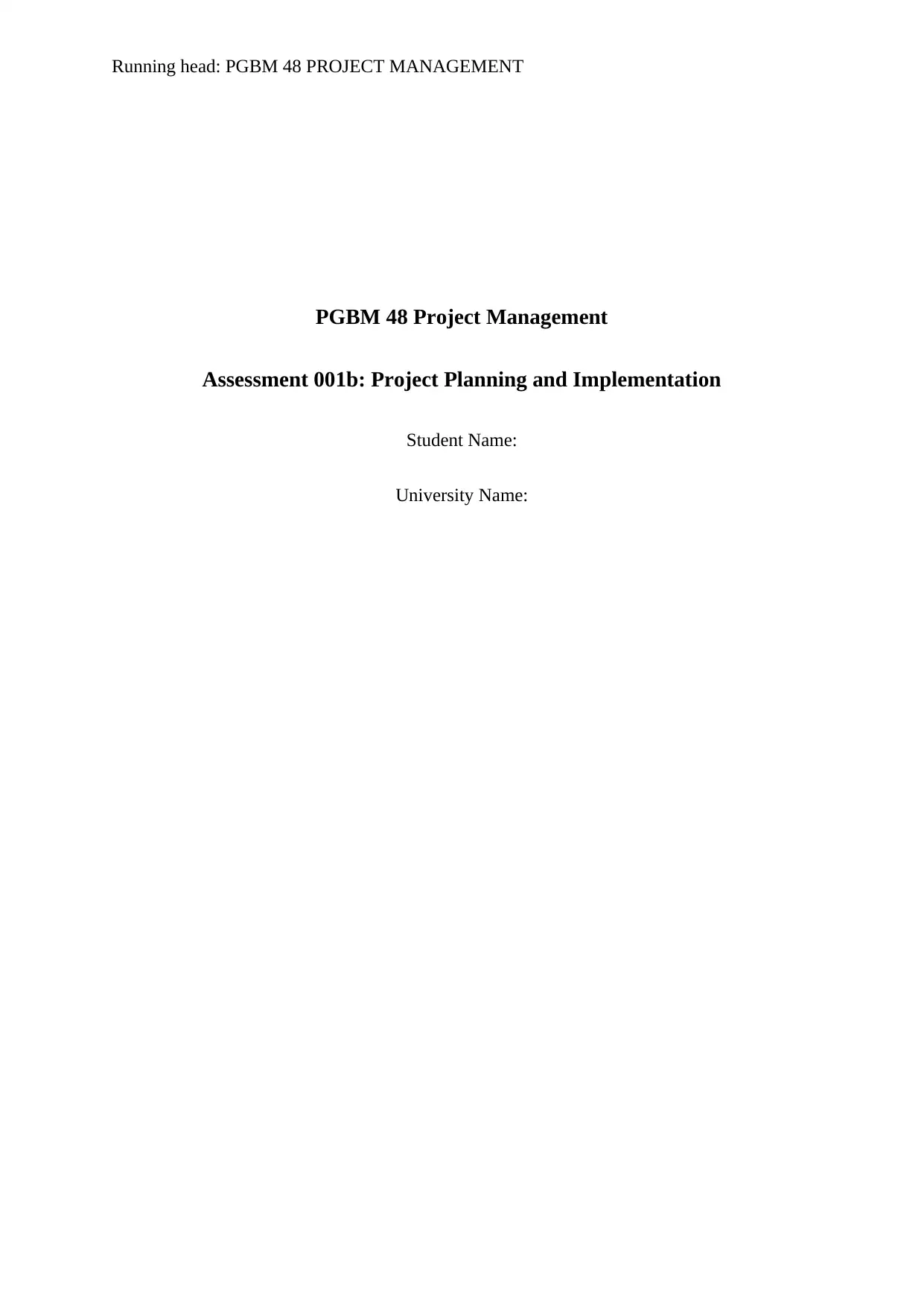
Running head: PGBM 48 PROJECT MANAGEMENT
PGBM 48 Project Management
Assessment 001b: Project Planning and Implementation
Student Name:
University Name:
PGBM 48 Project Management
Assessment 001b: Project Planning and Implementation
Student Name:
University Name:
Paraphrase This Document
Need a fresh take? Get an instant paraphrase of this document with our AI Paraphraser
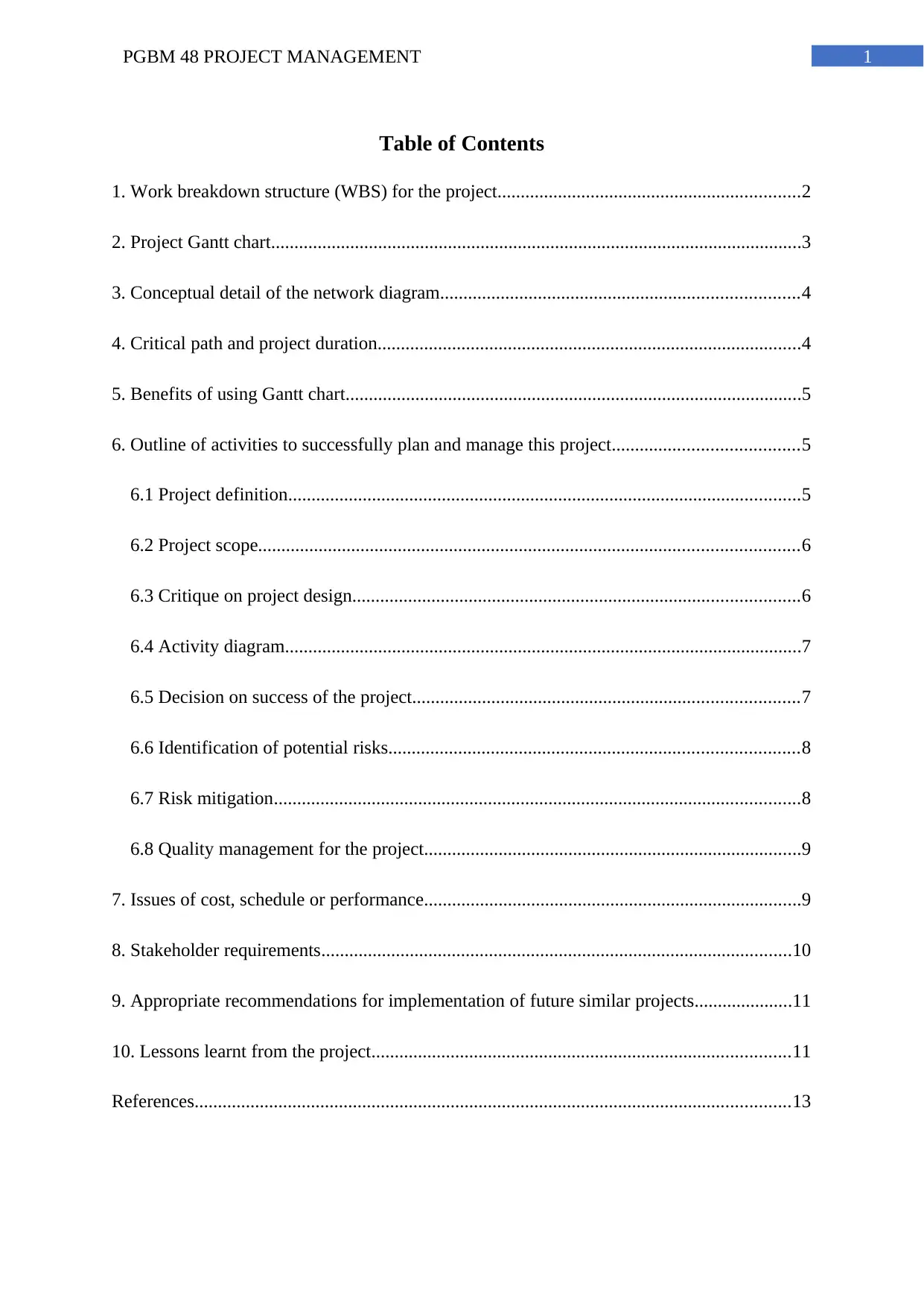
1PGBM 48 PROJECT MANAGEMENT
Table of Contents
1. Work breakdown structure (WBS) for the project.................................................................2
2. Project Gantt chart..................................................................................................................3
3. Conceptual detail of the network diagram.............................................................................4
4. Critical path and project duration...........................................................................................4
5. Benefits of using Gantt chart..................................................................................................5
6. Outline of activities to successfully plan and manage this project........................................5
6.1 Project definition..............................................................................................................5
6.2 Project scope....................................................................................................................6
6.3 Critique on project design................................................................................................6
6.4 Activity diagram...............................................................................................................7
6.5 Decision on success of the project...................................................................................7
6.6 Identification of potential risks........................................................................................8
6.7 Risk mitigation.................................................................................................................8
6.8 Quality management for the project.................................................................................9
7. Issues of cost, schedule or performance.................................................................................9
8. Stakeholder requirements.....................................................................................................10
9. Appropriate recommendations for implementation of future similar projects.....................11
10. Lessons learnt from the project..........................................................................................11
References................................................................................................................................13
Table of Contents
1. Work breakdown structure (WBS) for the project.................................................................2
2. Project Gantt chart..................................................................................................................3
3. Conceptual detail of the network diagram.............................................................................4
4. Critical path and project duration...........................................................................................4
5. Benefits of using Gantt chart..................................................................................................5
6. Outline of activities to successfully plan and manage this project........................................5
6.1 Project definition..............................................................................................................5
6.2 Project scope....................................................................................................................6
6.3 Critique on project design................................................................................................6
6.4 Activity diagram...............................................................................................................7
6.5 Decision on success of the project...................................................................................7
6.6 Identification of potential risks........................................................................................8
6.7 Risk mitigation.................................................................................................................8
6.8 Quality management for the project.................................................................................9
7. Issues of cost, schedule or performance.................................................................................9
8. Stakeholder requirements.....................................................................................................10
9. Appropriate recommendations for implementation of future similar projects.....................11
10. Lessons learnt from the project..........................................................................................11
References................................................................................................................................13
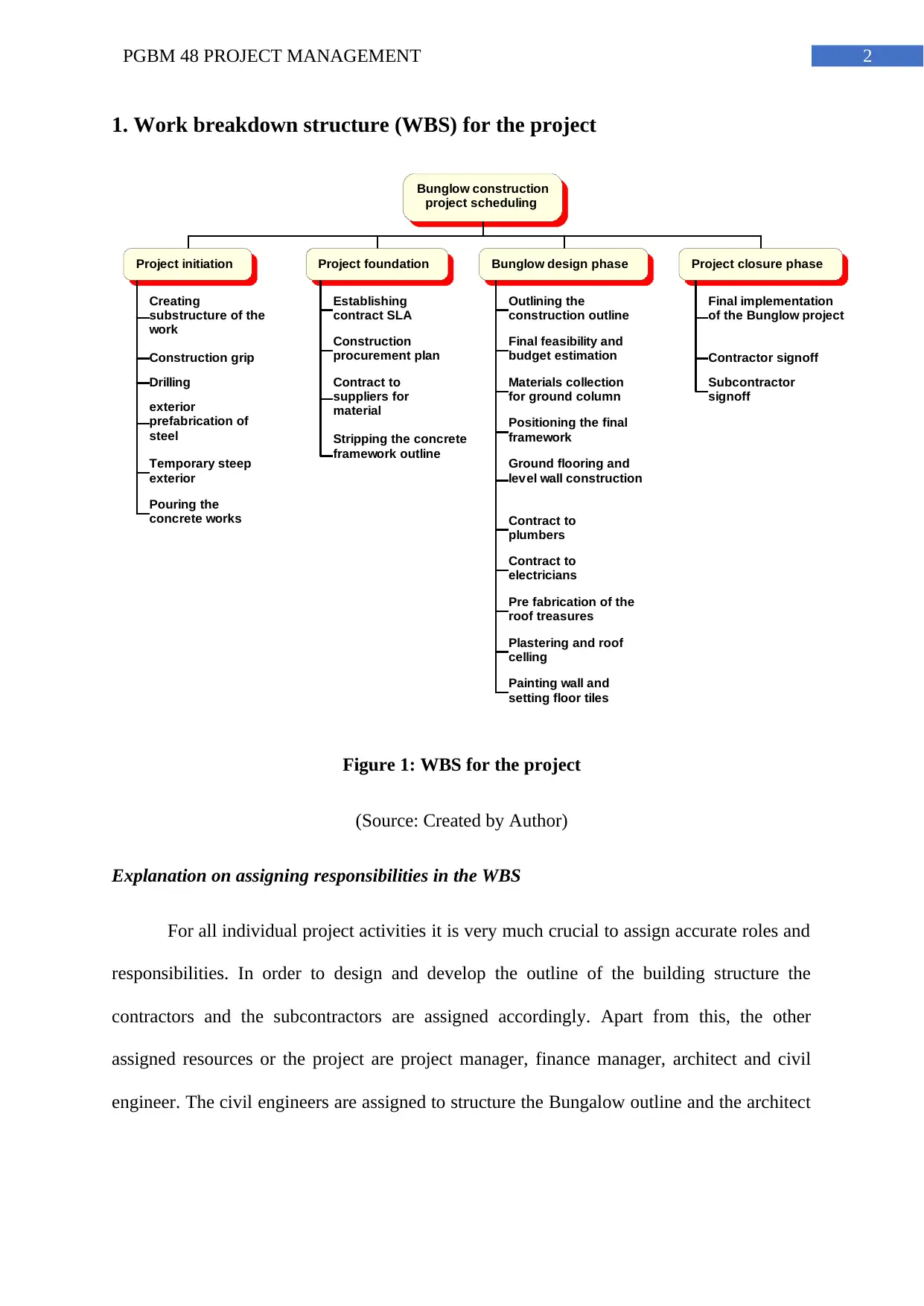
2PGBM 48 PROJECT MANAGEMENT
1. Work breakdown structure (WBS) for the project
Bunglow construction
project scheduling
Project initiation
Creating
substructure of the
work
Construction grip
Drilling
exterior
prefabrication of
steel
Temporary steep
exterior
Pouring the
concrete works
Project foundation
Establishing
contract SLA
Construction
procurement plan
Contract to
suppliers for
material
Stripping the concrete
framework outline
Bunglow design phase
Outlining the
construction outline
Final feasibility and
budget estimation
Materials collection
for ground column
Positioning the final
framework
Ground flooring and
level wall construction
Contract to
plumbers
Contract to
electricians
Pre fabrication of the
roof treasures
Plastering and roof
celling
Painting wall and
setting floor tiles
Project closure phase
Final implementation
of the Bunglow project
Contractor signoff
Subcontractor
signoff
Figure 1: WBS for the project
(Source: Created by Author)
Explanation on assigning responsibilities in the WBS
For all individual project activities it is very much crucial to assign accurate roles and
responsibilities. In order to design and develop the outline of the building structure the
contractors and the subcontractors are assigned accordingly. Apart from this, the other
assigned resources or the project are project manager, finance manager, architect and civil
engineer. The civil engineers are assigned to structure the Bungalow outline and the architect
1. Work breakdown structure (WBS) for the project
Bunglow construction
project scheduling
Project initiation
Creating
substructure of the
work
Construction grip
Drilling
exterior
prefabrication of
steel
Temporary steep
exterior
Pouring the
concrete works
Project foundation
Establishing
contract SLA
Construction
procurement plan
Contract to
suppliers for
material
Stripping the concrete
framework outline
Bunglow design phase
Outlining the
construction outline
Final feasibility and
budget estimation
Materials collection
for ground column
Positioning the final
framework
Ground flooring and
level wall construction
Contract to
plumbers
Contract to
electricians
Pre fabrication of the
roof treasures
Plastering and roof
celling
Painting wall and
setting floor tiles
Project closure phase
Final implementation
of the Bunglow project
Contractor signoff
Subcontractor
signoff
Figure 1: WBS for the project
(Source: Created by Author)
Explanation on assigning responsibilities in the WBS
For all individual project activities it is very much crucial to assign accurate roles and
responsibilities. In order to design and develop the outline of the building structure the
contractors and the subcontractors are assigned accordingly. Apart from this, the other
assigned resources or the project are project manager, finance manager, architect and civil
engineer. The civil engineers are assigned to structure the Bungalow outline and the architect
⊘ This is a preview!⊘
Do you want full access?
Subscribe today to unlock all pages.

Trusted by 1+ million students worldwide
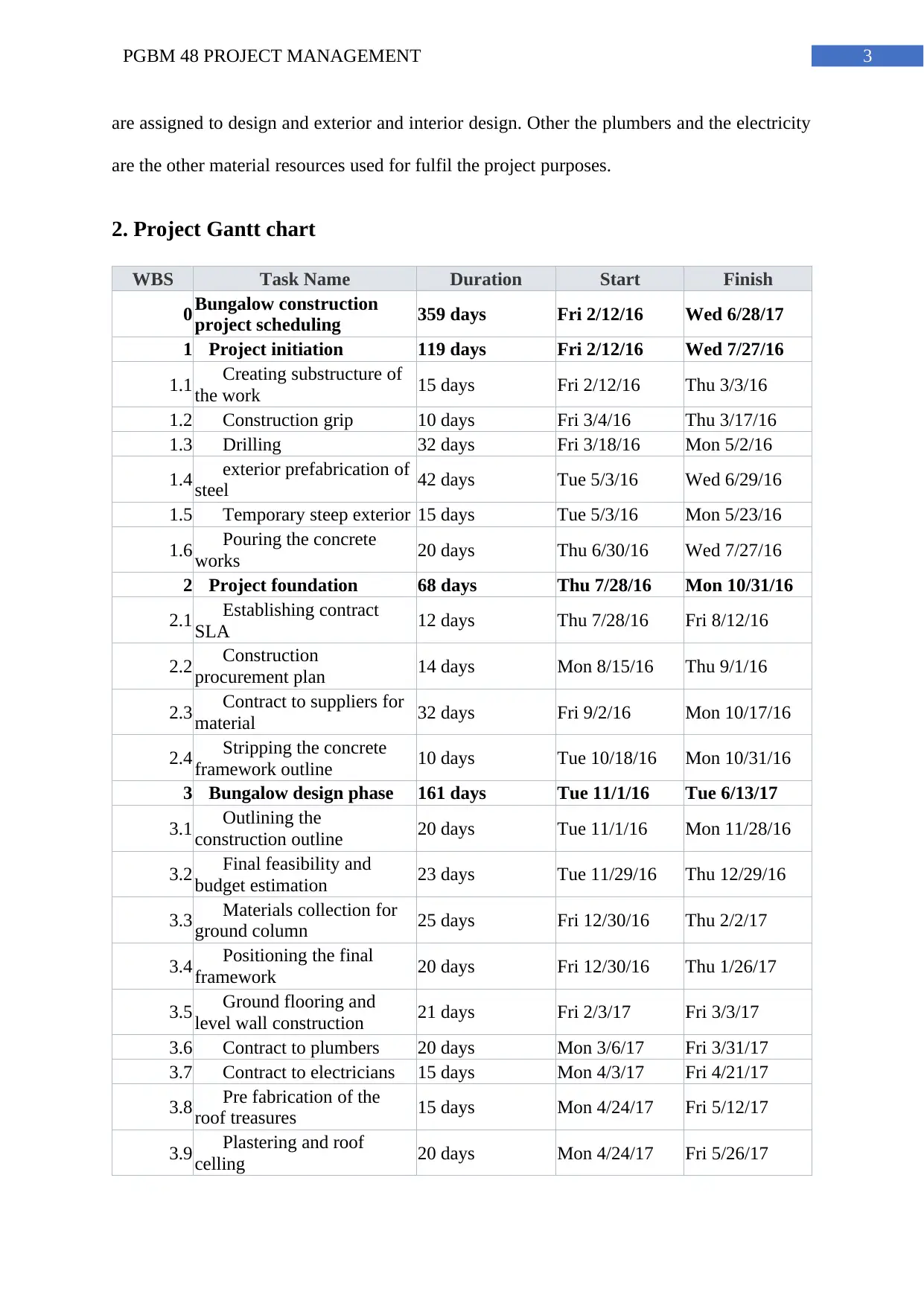
3PGBM 48 PROJECT MANAGEMENT
are assigned to design and exterior and interior design. Other the plumbers and the electricity
are the other material resources used for fulfil the project purposes.
2. Project Gantt chart
WBS Task Name Duration Start Finish
0 Bungalow construction
project scheduling 359 days Fri 2/12/16 Wed 6/28/17
1 Project initiation 119 days Fri 2/12/16 Wed 7/27/16
1.1 Creating substructure of
the work 15 days Fri 2/12/16 Thu 3/3/16
1.2 Construction grip 10 days Fri 3/4/16 Thu 3/17/16
1.3 Drilling 32 days Fri 3/18/16 Mon 5/2/16
1.4 exterior prefabrication of
steel 42 days Tue 5/3/16 Wed 6/29/16
1.5 Temporary steep exterior 15 days Tue 5/3/16 Mon 5/23/16
1.6 Pouring the concrete
works 20 days Thu 6/30/16 Wed 7/27/16
2 Project foundation 68 days Thu 7/28/16 Mon 10/31/16
2.1 Establishing contract
SLA 12 days Thu 7/28/16 Fri 8/12/16
2.2 Construction
procurement plan 14 days Mon 8/15/16 Thu 9/1/16
2.3 Contract to suppliers for
material 32 days Fri 9/2/16 Mon 10/17/16
2.4 Stripping the concrete
framework outline 10 days Tue 10/18/16 Mon 10/31/16
3 Bungalow design phase 161 days Tue 11/1/16 Tue 6/13/17
3.1 Outlining the
construction outline 20 days Tue 11/1/16 Mon 11/28/16
3.2 Final feasibility and
budget estimation 23 days Tue 11/29/16 Thu 12/29/16
3.3 Materials collection for
ground column 25 days Fri 12/30/16 Thu 2/2/17
3.4 Positioning the final
framework 20 days Fri 12/30/16 Thu 1/26/17
3.5 Ground flooring and
level wall construction 21 days Fri 2/3/17 Fri 3/3/17
3.6 Contract to plumbers 20 days Mon 3/6/17 Fri 3/31/17
3.7 Contract to electricians 15 days Mon 4/3/17 Fri 4/21/17
3.8 Pre fabrication of the
roof treasures 15 days Mon 4/24/17 Fri 5/12/17
3.9 Plastering and roof
celling 20 days Mon 4/24/17 Fri 5/26/17
are assigned to design and exterior and interior design. Other the plumbers and the electricity
are the other material resources used for fulfil the project purposes.
2. Project Gantt chart
WBS Task Name Duration Start Finish
0 Bungalow construction
project scheduling 359 days Fri 2/12/16 Wed 6/28/17
1 Project initiation 119 days Fri 2/12/16 Wed 7/27/16
1.1 Creating substructure of
the work 15 days Fri 2/12/16 Thu 3/3/16
1.2 Construction grip 10 days Fri 3/4/16 Thu 3/17/16
1.3 Drilling 32 days Fri 3/18/16 Mon 5/2/16
1.4 exterior prefabrication of
steel 42 days Tue 5/3/16 Wed 6/29/16
1.5 Temporary steep exterior 15 days Tue 5/3/16 Mon 5/23/16
1.6 Pouring the concrete
works 20 days Thu 6/30/16 Wed 7/27/16
2 Project foundation 68 days Thu 7/28/16 Mon 10/31/16
2.1 Establishing contract
SLA 12 days Thu 7/28/16 Fri 8/12/16
2.2 Construction
procurement plan 14 days Mon 8/15/16 Thu 9/1/16
2.3 Contract to suppliers for
material 32 days Fri 9/2/16 Mon 10/17/16
2.4 Stripping the concrete
framework outline 10 days Tue 10/18/16 Mon 10/31/16
3 Bungalow design phase 161 days Tue 11/1/16 Tue 6/13/17
3.1 Outlining the
construction outline 20 days Tue 11/1/16 Mon 11/28/16
3.2 Final feasibility and
budget estimation 23 days Tue 11/29/16 Thu 12/29/16
3.3 Materials collection for
ground column 25 days Fri 12/30/16 Thu 2/2/17
3.4 Positioning the final
framework 20 days Fri 12/30/16 Thu 1/26/17
3.5 Ground flooring and
level wall construction 21 days Fri 2/3/17 Fri 3/3/17
3.6 Contract to plumbers 20 days Mon 3/6/17 Fri 3/31/17
3.7 Contract to electricians 15 days Mon 4/3/17 Fri 4/21/17
3.8 Pre fabrication of the
roof treasures 15 days Mon 4/24/17 Fri 5/12/17
3.9 Plastering and roof
celling 20 days Mon 4/24/17 Fri 5/26/17
Paraphrase This Document
Need a fresh take? Get an instant paraphrase of this document with our AI Paraphraser
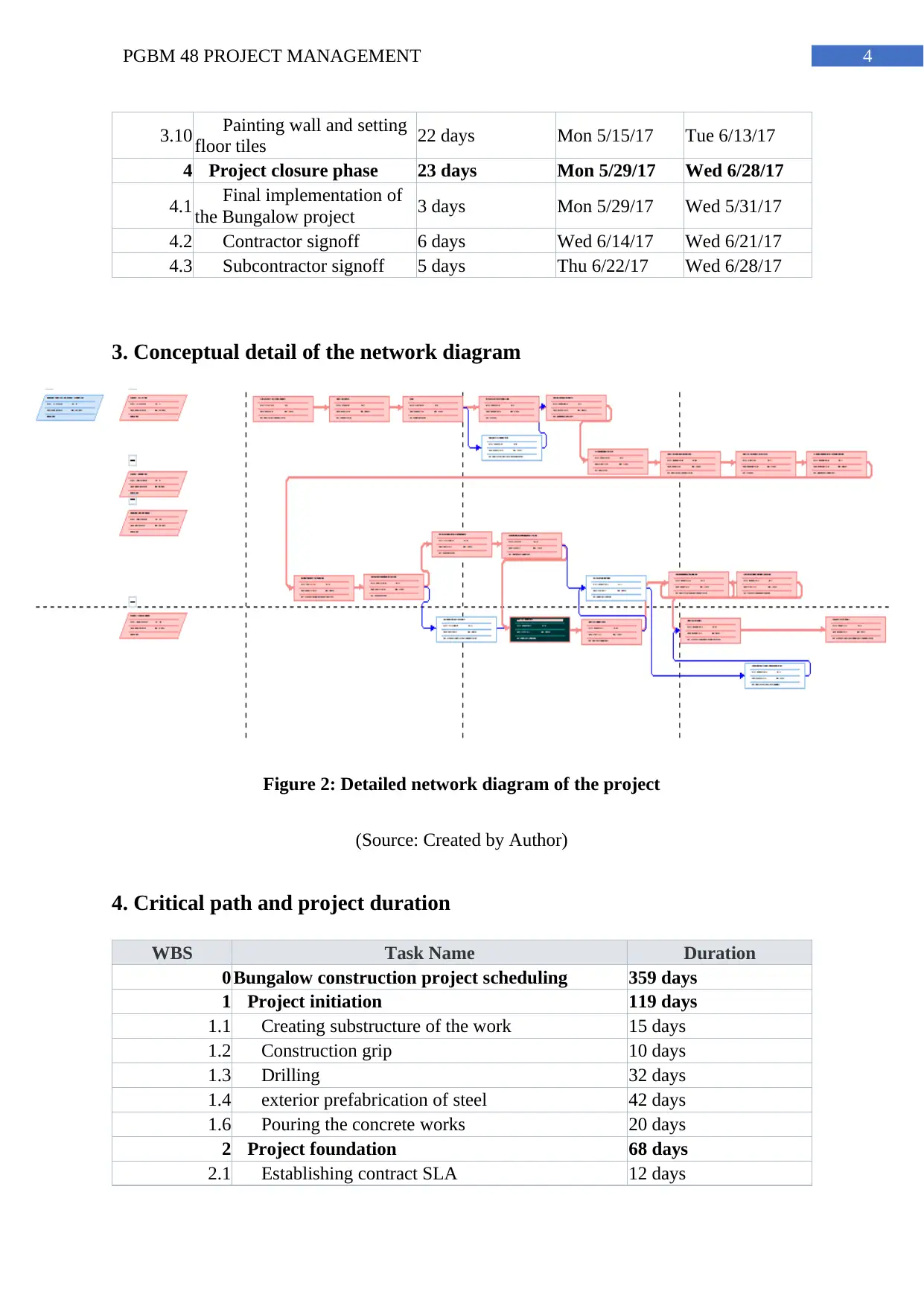
4PGBM 48 PROJECT MANAGEMENT
3.10 Painting wall and setting
floor tiles 22 days Mon 5/15/17 Tue 6/13/17
4 Project closure phase 23 days Mon 5/29/17 Wed 6/28/17
4.1 Final implementation of
the Bungalow project 3 days Mon 5/29/17 Wed 5/31/17
4.2 Contractor signoff 6 days Wed 6/14/17 Wed 6/21/17
4.3 Subcontractor signoff 5 days Thu 6/22/17 Wed 6/28/17
3. Conceptual detail of the network diagram
Figure 2: Detailed network diagram of the project
(Source: Created by Author)
4. Critical path and project duration
WBS Task Name Duration
0 Bungalow construction project scheduling 359 days
1 Project initiation 119 days
1.1 Creating substructure of the work 15 days
1.2 Construction grip 10 days
1.3 Drilling 32 days
1.4 exterior prefabrication of steel 42 days
1.6 Pouring the concrete works 20 days
2 Project foundation 68 days
2.1 Establishing contract SLA 12 days
3.10 Painting wall and setting
floor tiles 22 days Mon 5/15/17 Tue 6/13/17
4 Project closure phase 23 days Mon 5/29/17 Wed 6/28/17
4.1 Final implementation of
the Bungalow project 3 days Mon 5/29/17 Wed 5/31/17
4.2 Contractor signoff 6 days Wed 6/14/17 Wed 6/21/17
4.3 Subcontractor signoff 5 days Thu 6/22/17 Wed 6/28/17
3. Conceptual detail of the network diagram
Figure 2: Detailed network diagram of the project
(Source: Created by Author)
4. Critical path and project duration
WBS Task Name Duration
0 Bungalow construction project scheduling 359 days
1 Project initiation 119 days
1.1 Creating substructure of the work 15 days
1.2 Construction grip 10 days
1.3 Drilling 32 days
1.4 exterior prefabrication of steel 42 days
1.6 Pouring the concrete works 20 days
2 Project foundation 68 days
2.1 Establishing contract SLA 12 days
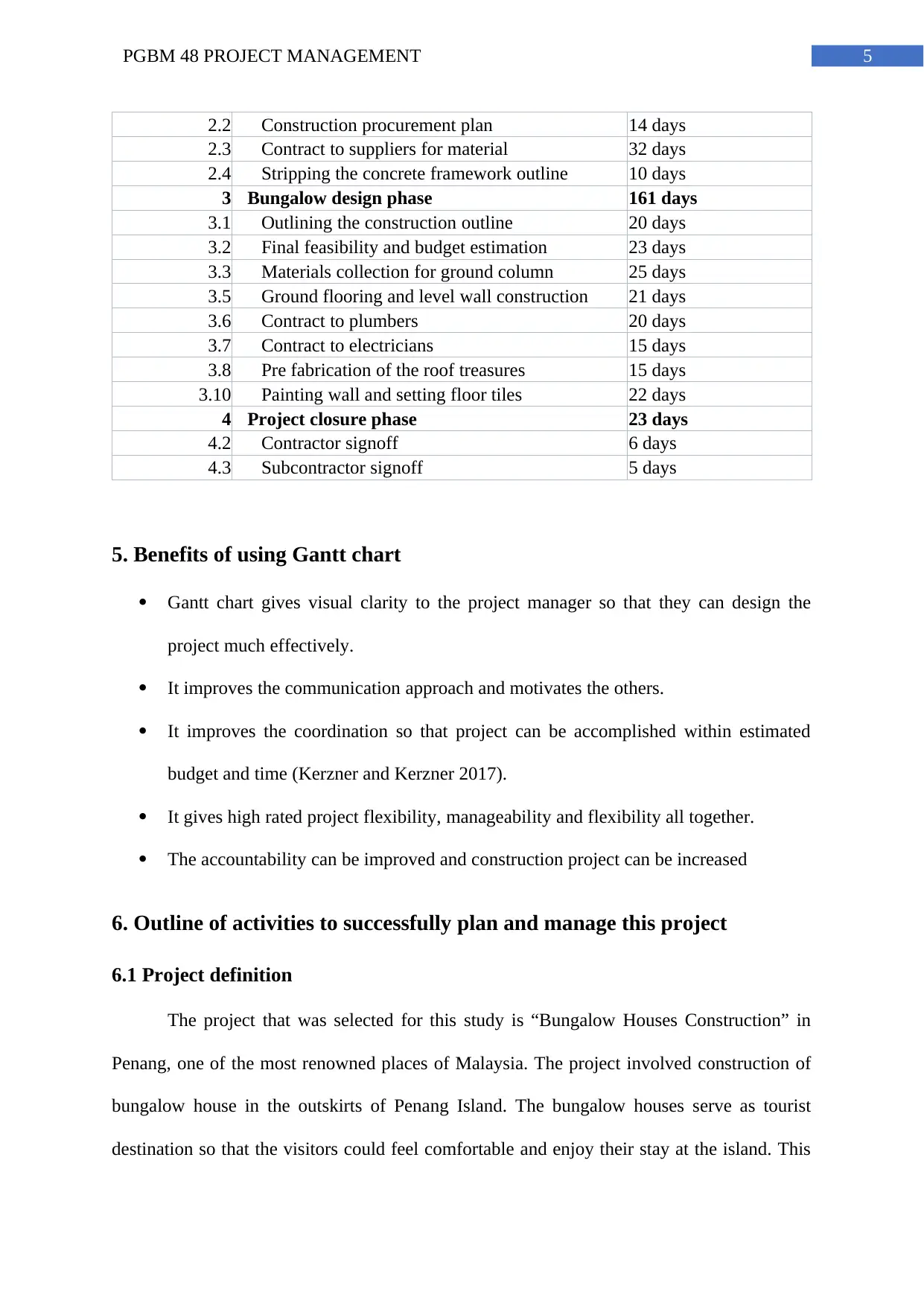
5PGBM 48 PROJECT MANAGEMENT
2.2 Construction procurement plan 14 days
2.3 Contract to suppliers for material 32 days
2.4 Stripping the concrete framework outline 10 days
3 Bungalow design phase 161 days
3.1 Outlining the construction outline 20 days
3.2 Final feasibility and budget estimation 23 days
3.3 Materials collection for ground column 25 days
3.5 Ground flooring and level wall construction 21 days
3.6 Contract to plumbers 20 days
3.7 Contract to electricians 15 days
3.8 Pre fabrication of the roof treasures 15 days
3.10 Painting wall and setting floor tiles 22 days
4 Project closure phase 23 days
4.2 Contractor signoff 6 days
4.3 Subcontractor signoff 5 days
5. Benefits of using Gantt chart
Gantt chart gives visual clarity to the project manager so that they can design the
project much effectively.
It improves the communication approach and motivates the others.
It improves the coordination so that project can be accomplished within estimated
budget and time (Kerzner and Kerzner 2017).
It gives high rated project flexibility, manageability and flexibility all together.
The accountability can be improved and construction project can be increased
6. Outline of activities to successfully plan and manage this project
6.1 Project definition
The project that was selected for this study is “Bungalow Houses Construction” in
Penang, one of the most renowned places of Malaysia. The project involved construction of
bungalow house in the outskirts of Penang Island. The bungalow houses serve as tourist
destination so that the visitors could feel comfortable and enjoy their stay at the island. This
2.2 Construction procurement plan 14 days
2.3 Contract to suppliers for material 32 days
2.4 Stripping the concrete framework outline 10 days
3 Bungalow design phase 161 days
3.1 Outlining the construction outline 20 days
3.2 Final feasibility and budget estimation 23 days
3.3 Materials collection for ground column 25 days
3.5 Ground flooring and level wall construction 21 days
3.6 Contract to plumbers 20 days
3.7 Contract to electricians 15 days
3.8 Pre fabrication of the roof treasures 15 days
3.10 Painting wall and setting floor tiles 22 days
4 Project closure phase 23 days
4.2 Contractor signoff 6 days
4.3 Subcontractor signoff 5 days
5. Benefits of using Gantt chart
Gantt chart gives visual clarity to the project manager so that they can design the
project much effectively.
It improves the communication approach and motivates the others.
It improves the coordination so that project can be accomplished within estimated
budget and time (Kerzner and Kerzner 2017).
It gives high rated project flexibility, manageability and flexibility all together.
The accountability can be improved and construction project can be increased
6. Outline of activities to successfully plan and manage this project
6.1 Project definition
The project that was selected for this study is “Bungalow Houses Construction” in
Penang, one of the most renowned places of Malaysia. The project involved construction of
bungalow house in the outskirts of Penang Island. The bungalow houses serve as tourist
destination so that the visitors could feel comfortable and enjoy their stay at the island. This
⊘ This is a preview!⊘
Do you want full access?
Subscribe today to unlock all pages.

Trusted by 1+ million students worldwide

6PGBM 48 PROJECT MANAGEMENT
project was undertaken by Ong Han Meng Construction Sdn Bhd which is one of the major
construction companies located in Penang. This project comprised of major five phases that is
initiation, planning, execution, controlling or monitoring and closure.
6.2 Project scope
The scope of this project was construction of bungalow houses and the major
deliverable was completion of the construction activities. This project was based on
development of bungalow houses so that the visitors can enjoy their stay at the island. The
scope of this project comprised of planning, designing, and execution as well as closure
activities. The monitoring and controlling activities after completion of the project were out
of the project scope.
6.3 Critique on project design
The project goal was to accomplish the development of Bungalow houses for tourists
and it has been clearly defined along with it the objectives have been clearly demonstrated so
that the project could be completed successfully. The parent organization maintains a
hierarchical structure and they are involved at every stage of the project. The project
environment is referred to as the connection where a project is being processed and that has
impact on the project. The project environment is not clear in context to this particular project
on Bungalow construction in Penang Island.
project was undertaken by Ong Han Meng Construction Sdn Bhd which is one of the major
construction companies located in Penang. This project comprised of major five phases that is
initiation, planning, execution, controlling or monitoring and closure.
6.2 Project scope
The scope of this project was construction of bungalow houses and the major
deliverable was completion of the construction activities. This project was based on
development of bungalow houses so that the visitors can enjoy their stay at the island. The
scope of this project comprised of planning, designing, and execution as well as closure
activities. The monitoring and controlling activities after completion of the project were out
of the project scope.
6.3 Critique on project design
The project goal was to accomplish the development of Bungalow houses for tourists
and it has been clearly defined along with it the objectives have been clearly demonstrated so
that the project could be completed successfully. The parent organization maintains a
hierarchical structure and they are involved at every stage of the project. The project
environment is referred to as the connection where a project is being processed and that has
impact on the project. The project environment is not clear in context to this particular project
on Bungalow construction in Penang Island.
Paraphrase This Document
Need a fresh take? Get an instant paraphrase of this document with our AI Paraphraser
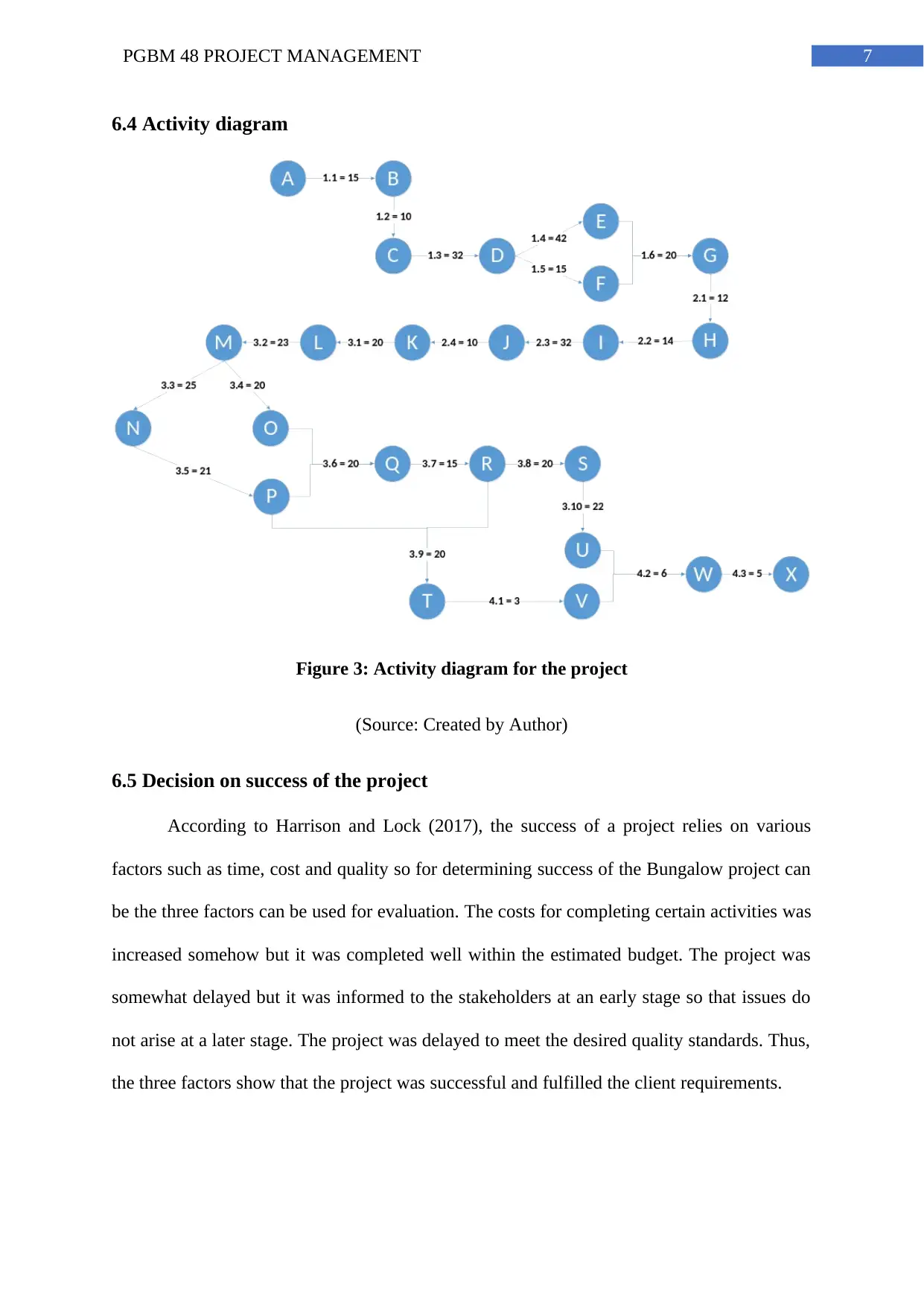
7PGBM 48 PROJECT MANAGEMENT
6.4 Activity diagram
Figure 3: Activity diagram for the project
(Source: Created by Author)
6.5 Decision on success of the project
According to Harrison and Lock (2017), the success of a project relies on various
factors such as time, cost and quality so for determining success of the Bungalow project can
be the three factors can be used for evaluation. The costs for completing certain activities was
increased somehow but it was completed well within the estimated budget. The project was
somewhat delayed but it was informed to the stakeholders at an early stage so that issues do
not arise at a later stage. The project was delayed to meet the desired quality standards. Thus,
the three factors show that the project was successful and fulfilled the client requirements.
6.4 Activity diagram
Figure 3: Activity diagram for the project
(Source: Created by Author)
6.5 Decision on success of the project
According to Harrison and Lock (2017), the success of a project relies on various
factors such as time, cost and quality so for determining success of the Bungalow project can
be the three factors can be used for evaluation. The costs for completing certain activities was
increased somehow but it was completed well within the estimated budget. The project was
somewhat delayed but it was informed to the stakeholders at an early stage so that issues do
not arise at a later stage. The project was delayed to meet the desired quality standards. Thus,
the three factors show that the project was successful and fulfilled the client requirements.
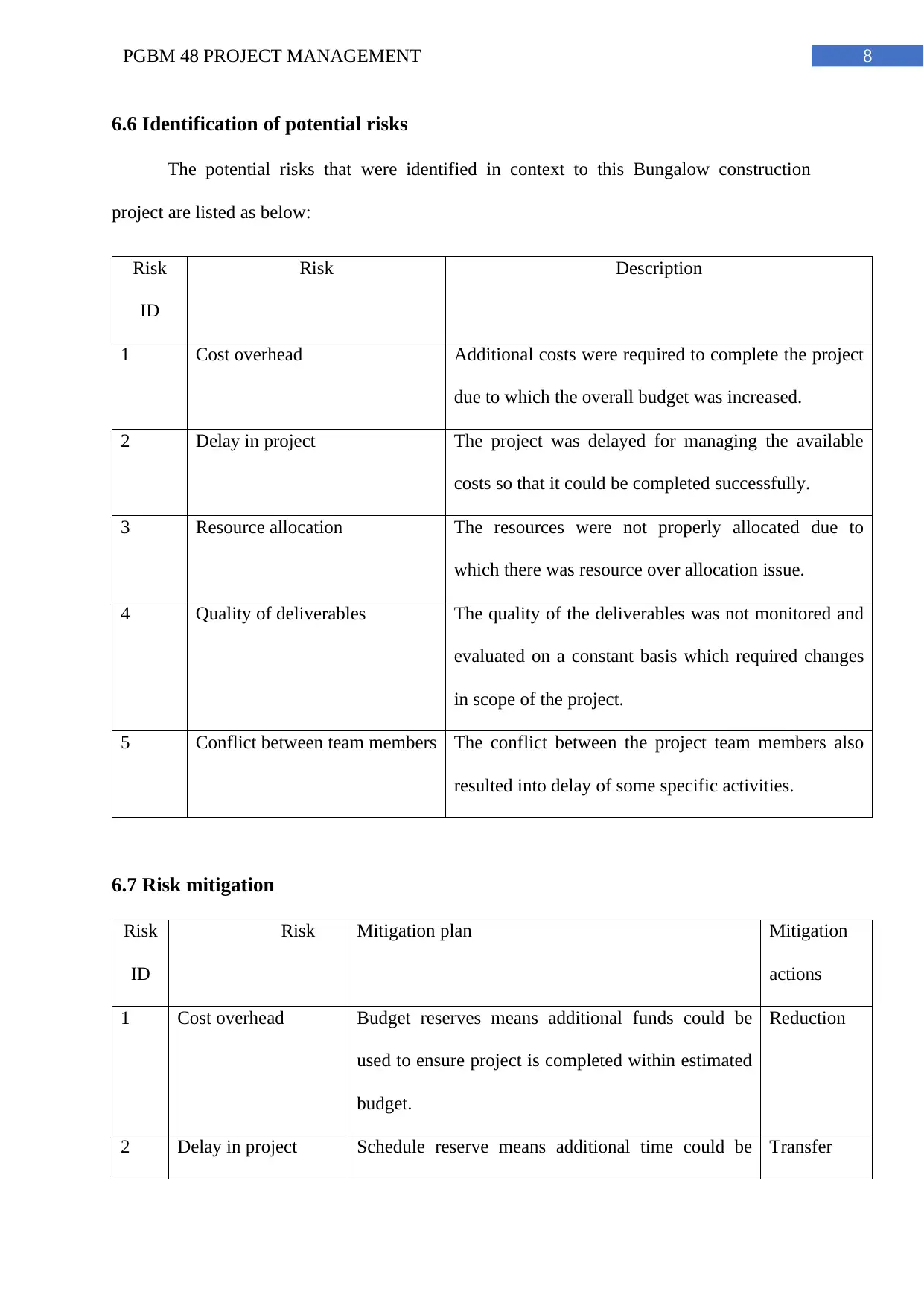
8PGBM 48 PROJECT MANAGEMENT
6.6 Identification of potential risks
The potential risks that were identified in context to this Bungalow construction
project are listed as below:
Risk
ID
Risk Description
1 Cost overhead Additional costs were required to complete the project
due to which the overall budget was increased.
2 Delay in project The project was delayed for managing the available
costs so that it could be completed successfully.
3 Resource allocation The resources were not properly allocated due to
which there was resource over allocation issue.
4 Quality of deliverables The quality of the deliverables was not monitored and
evaluated on a constant basis which required changes
in scope of the project.
5 Conflict between team members The conflict between the project team members also
resulted into delay of some specific activities.
6.7 Risk mitigation
Risk
ID
Risk Mitigation plan Mitigation
actions
1 Cost overhead Budget reserves means additional funds could be
used to ensure project is completed within estimated
budget.
Reduction
2 Delay in project Schedule reserve means additional time could be Transfer
6.6 Identification of potential risks
The potential risks that were identified in context to this Bungalow construction
project are listed as below:
Risk
ID
Risk Description
1 Cost overhead Additional costs were required to complete the project
due to which the overall budget was increased.
2 Delay in project The project was delayed for managing the available
costs so that it could be completed successfully.
3 Resource allocation The resources were not properly allocated due to
which there was resource over allocation issue.
4 Quality of deliverables The quality of the deliverables was not monitored and
evaluated on a constant basis which required changes
in scope of the project.
5 Conflict between team members The conflict between the project team members also
resulted into delay of some specific activities.
6.7 Risk mitigation
Risk
ID
Risk Mitigation plan Mitigation
actions
1 Cost overhead Budget reserves means additional funds could be
used to ensure project is completed within estimated
budget.
Reduction
2 Delay in project Schedule reserve means additional time could be Transfer
⊘ This is a preview!⊘
Do you want full access?
Subscribe today to unlock all pages.

Trusted by 1+ million students worldwide
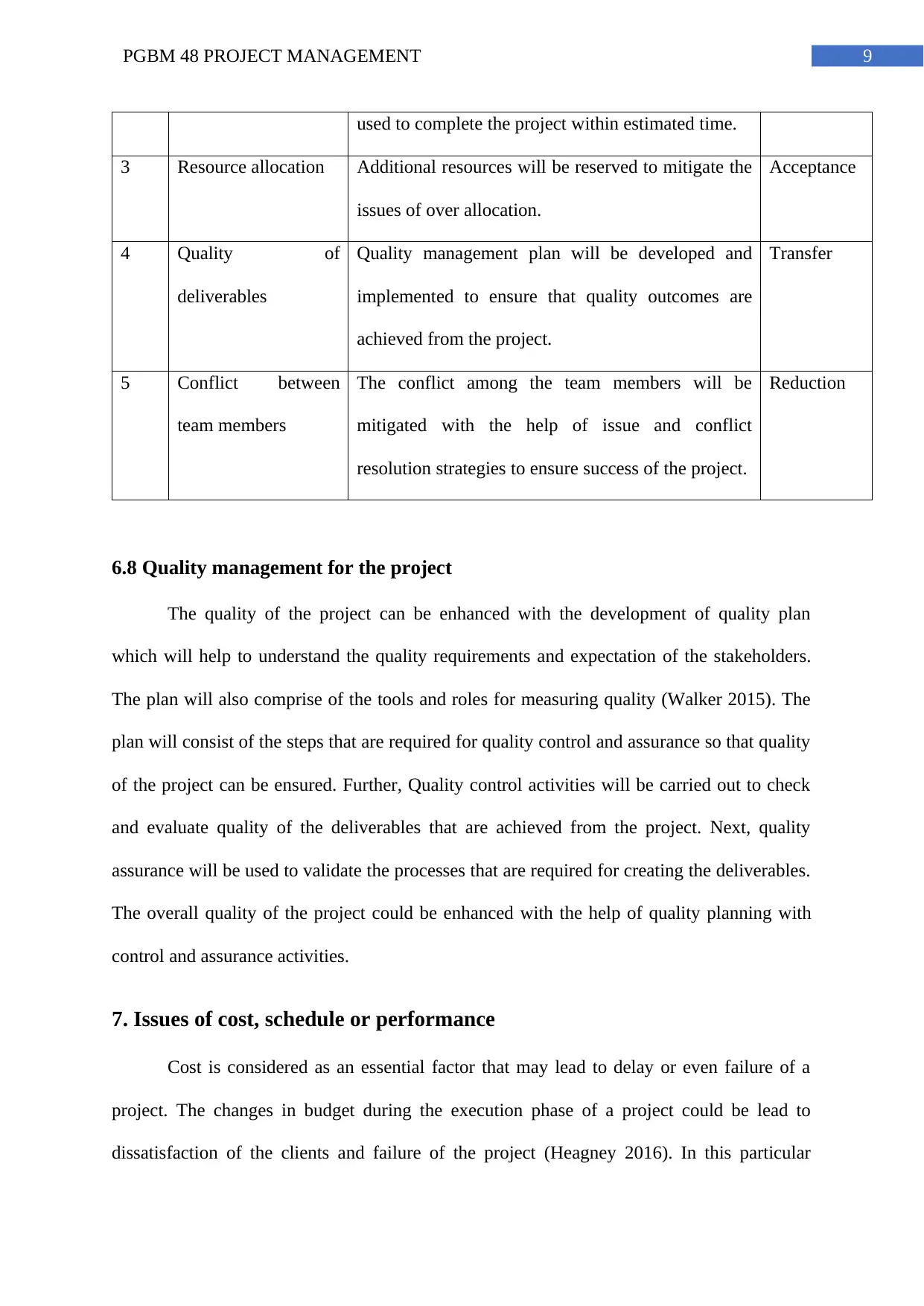
9PGBM 48 PROJECT MANAGEMENT
used to complete the project within estimated time.
3 Resource allocation Additional resources will be reserved to mitigate the
issues of over allocation.
Acceptance
4 Quality of
deliverables
Quality management plan will be developed and
implemented to ensure that quality outcomes are
achieved from the project.
Transfer
5 Conflict between
team members
The conflict among the team members will be
mitigated with the help of issue and conflict
resolution strategies to ensure success of the project.
Reduction
6.8 Quality management for the project
The quality of the project can be enhanced with the development of quality plan
which will help to understand the quality requirements and expectation of the stakeholders.
The plan will also comprise of the tools and roles for measuring quality (Walker 2015). The
plan will consist of the steps that are required for quality control and assurance so that quality
of the project can be ensured. Further, Quality control activities will be carried out to check
and evaluate quality of the deliverables that are achieved from the project. Next, quality
assurance will be used to validate the processes that are required for creating the deliverables.
The overall quality of the project could be enhanced with the help of quality planning with
control and assurance activities.
7. Issues of cost, schedule or performance
Cost is considered as an essential factor that may lead to delay or even failure of a
project. The changes in budget during the execution phase of a project could be lead to
dissatisfaction of the clients and failure of the project (Heagney 2016). In this particular
used to complete the project within estimated time.
3 Resource allocation Additional resources will be reserved to mitigate the
issues of over allocation.
Acceptance
4 Quality of
deliverables
Quality management plan will be developed and
implemented to ensure that quality outcomes are
achieved from the project.
Transfer
5 Conflict between
team members
The conflict among the team members will be
mitigated with the help of issue and conflict
resolution strategies to ensure success of the project.
Reduction
6.8 Quality management for the project
The quality of the project can be enhanced with the development of quality plan
which will help to understand the quality requirements and expectation of the stakeholders.
The plan will also comprise of the tools and roles for measuring quality (Walker 2015). The
plan will consist of the steps that are required for quality control and assurance so that quality
of the project can be ensured. Further, Quality control activities will be carried out to check
and evaluate quality of the deliverables that are achieved from the project. Next, quality
assurance will be used to validate the processes that are required for creating the deliverables.
The overall quality of the project could be enhanced with the help of quality planning with
control and assurance activities.
7. Issues of cost, schedule or performance
Cost is considered as an essential factor that may lead to delay or even failure of a
project. The changes in budget during the execution phase of a project could be lead to
dissatisfaction of the clients and failure of the project (Heagney 2016). In this particular
Paraphrase This Document
Need a fresh take? Get an instant paraphrase of this document with our AI Paraphraser

10PGBM 48 PROJECT MANAGEMENT
project, it has been identified that there was some issue of cost overhead but at a later stage
through implementation of proper change management approach. The project manager used
change management plan to ensure that the project was completed well within estimated
budget however it caused some delay to deliver the project.
Schedule is another important factor which determines the success or failure of a
project. The completion of a project as per the planned schedule by maintaining the desired
quality outcomes will ensure success of a project (Kerzner 2018). In this particular case on
Bungalow construction project in Penang Island, it has been identified that it was delayed to
meet the cost requirements. The project required more time to complete than the estimated
time and schedule but it was delivered with proper quality and fulfilling the client
requirements. The project consumed more time than the expected as during the execution
proper cost management was not done at the budget was not being followed. Finally, the
project was a success as the delay in project was informed by the project manager to the
stakeholders at an earlier stage.
Performance refers to the status of a project throughout the entire project lifecycle and
it directly impacts the cost as well as time for a project (Talman 2018). In this particular case
of Bungalow construction project, it has been identified that there was no such performance
issues as the project was being monitored on constant basis. The evaluation of the project was
being carried out by the Project manager to ensure that the deliverables are produced as per
requirements well within the estimated time and budget.
8. Stakeholder requirements
Stakeholders are the individuals that may be affected or have an impact on the project.
The stakeholder identification and analysis is an essential factor to ensure success of a project
along with fulfilment of the desired goals and objectives (Martinelli and Milosevic 2016).
project, it has been identified that there was some issue of cost overhead but at a later stage
through implementation of proper change management approach. The project manager used
change management plan to ensure that the project was completed well within estimated
budget however it caused some delay to deliver the project.
Schedule is another important factor which determines the success or failure of a
project. The completion of a project as per the planned schedule by maintaining the desired
quality outcomes will ensure success of a project (Kerzner 2018). In this particular case on
Bungalow construction project in Penang Island, it has been identified that it was delayed to
meet the cost requirements. The project required more time to complete than the estimated
time and schedule but it was delivered with proper quality and fulfilling the client
requirements. The project consumed more time than the expected as during the execution
proper cost management was not done at the budget was not being followed. Finally, the
project was a success as the delay in project was informed by the project manager to the
stakeholders at an earlier stage.
Performance refers to the status of a project throughout the entire project lifecycle and
it directly impacts the cost as well as time for a project (Talman 2018). In this particular case
of Bungalow construction project, it has been identified that there was no such performance
issues as the project was being monitored on constant basis. The evaluation of the project was
being carried out by the Project manager to ensure that the deliverables are produced as per
requirements well within the estimated time and budget.
8. Stakeholder requirements
Stakeholders are the individuals that may be affected or have an impact on the project.
The stakeholder identification and analysis is an essential factor to ensure success of a project
along with fulfilment of the desired goals and objectives (Martinelli and Milosevic 2016).

11PGBM 48 PROJECT MANAGEMENT
The stakeholder requirements that has been identified from this particular Bungalow
construction project are listed as below:
Successful completion of the project within estimated time and budget.
Quality of deliverables that will be achieved from the project.
Monitoring and controlling of the activities to ensure suitable performance
of the project.
The deliverables of the project meets the requirements and quality
standards.
9. Appropriate recommendations for implementation of future similar
projects
The implementation of future similar projects will require suitable planning and
management prior to execution of the project. Some of the recommendations for
implementation of similar projects in future are listed as below:
Proper project management approach have to be identified during the planning
phase.
Time and budget planning have to be done at an earlier stage so that project
could be completed successfully.
Proper time management and planning approach have to be implemented for
successful completion.
Progress of the project have to be monitored on a constant basis to ensure
delivery of quality outcomes.
The stakeholder requirements that has been identified from this particular Bungalow
construction project are listed as below:
Successful completion of the project within estimated time and budget.
Quality of deliverables that will be achieved from the project.
Monitoring and controlling of the activities to ensure suitable performance
of the project.
The deliverables of the project meets the requirements and quality
standards.
9. Appropriate recommendations for implementation of future similar
projects
The implementation of future similar projects will require suitable planning and
management prior to execution of the project. Some of the recommendations for
implementation of similar projects in future are listed as below:
Proper project management approach have to be identified during the planning
phase.
Time and budget planning have to be done at an earlier stage so that project
could be completed successfully.
Proper time management and planning approach have to be implemented for
successful completion.
Progress of the project have to be monitored on a constant basis to ensure
delivery of quality outcomes.
⊘ This is a preview!⊘
Do you want full access?
Subscribe today to unlock all pages.

Trusted by 1+ million students worldwide
1 out of 15
Your All-in-One AI-Powered Toolkit for Academic Success.
+13062052269
info@desklib.com
Available 24*7 on WhatsApp / Email
![[object Object]](/_next/static/media/star-bottom.7253800d.svg)
Unlock your academic potential
Copyright © 2020–2025 A2Z Services. All Rights Reserved. Developed and managed by ZUCOL.